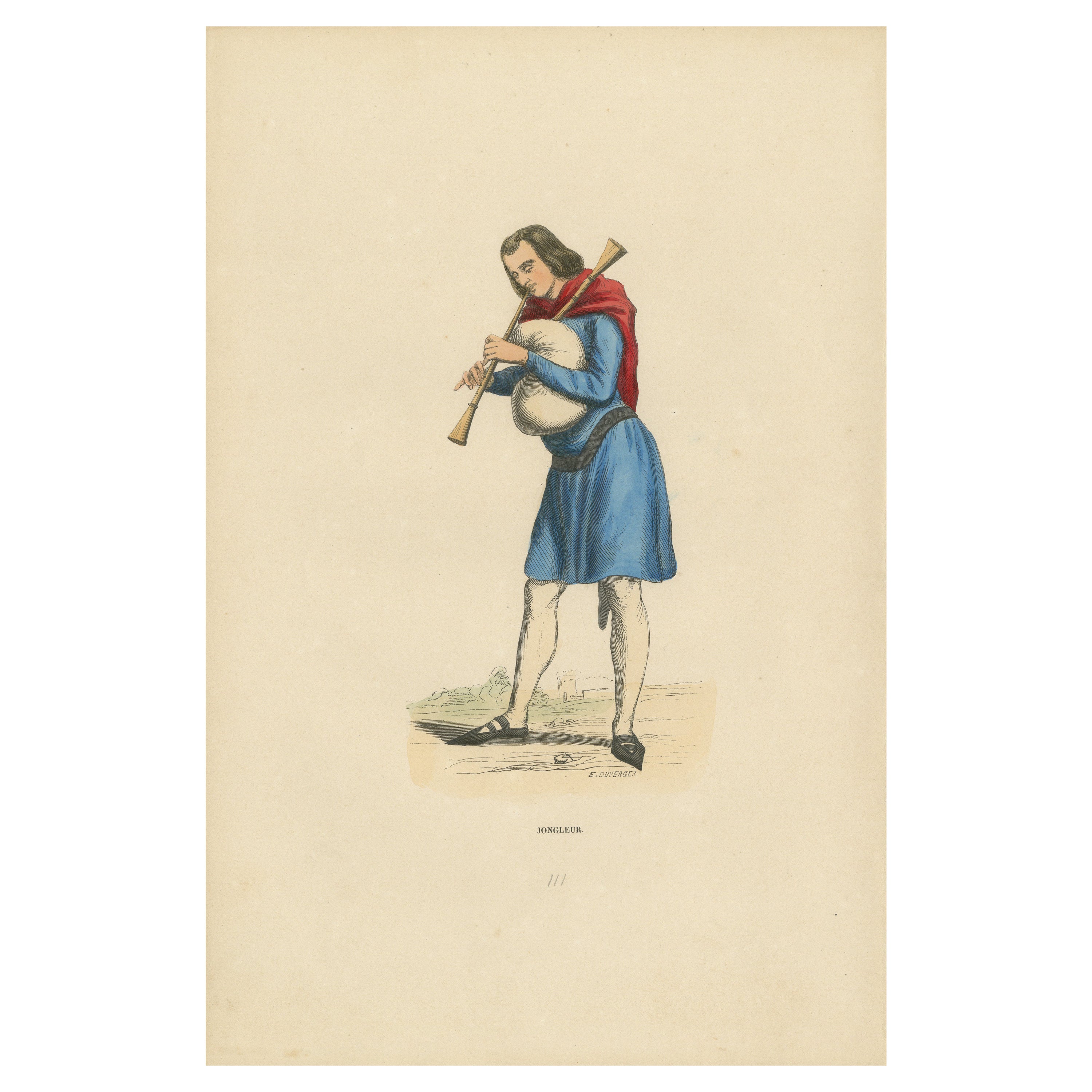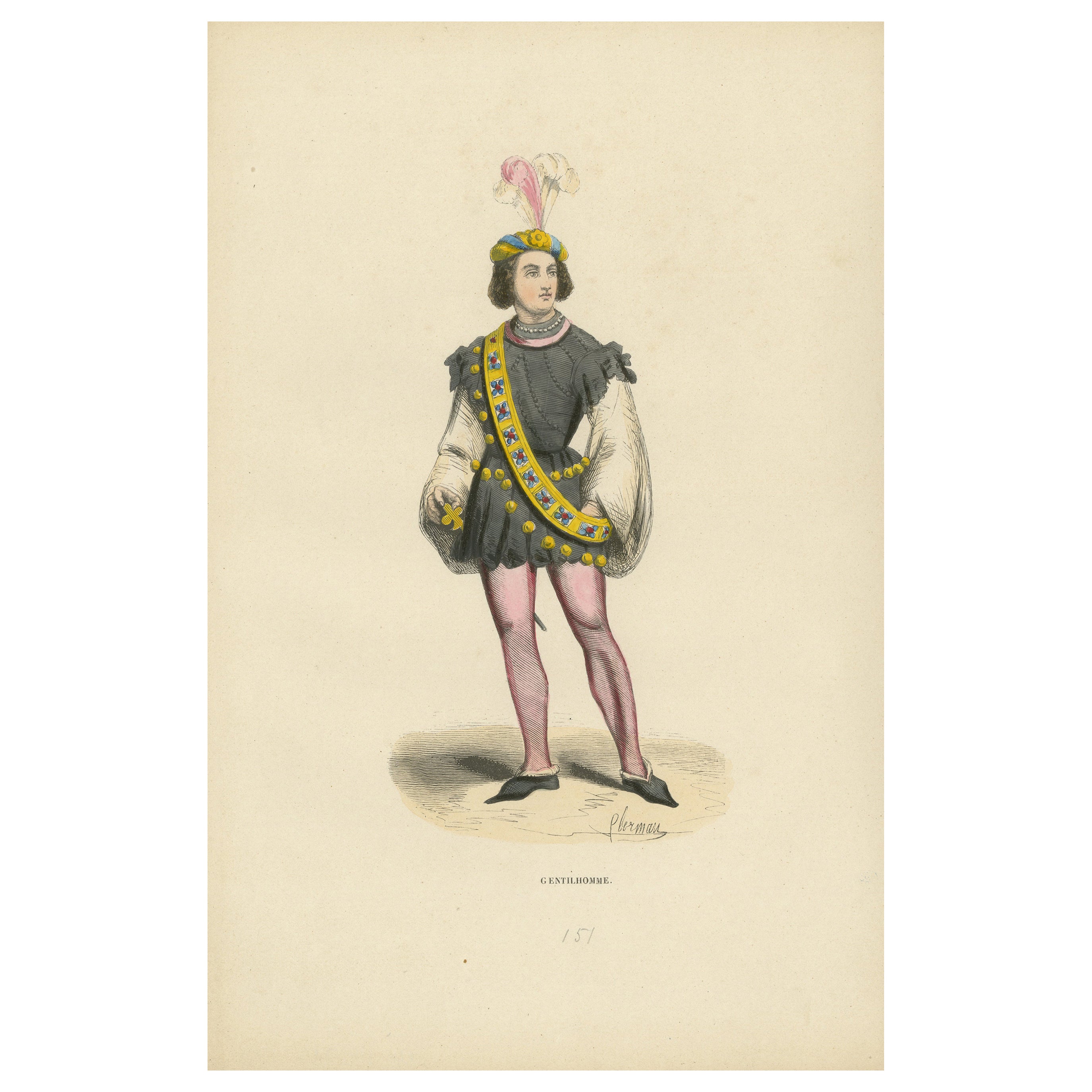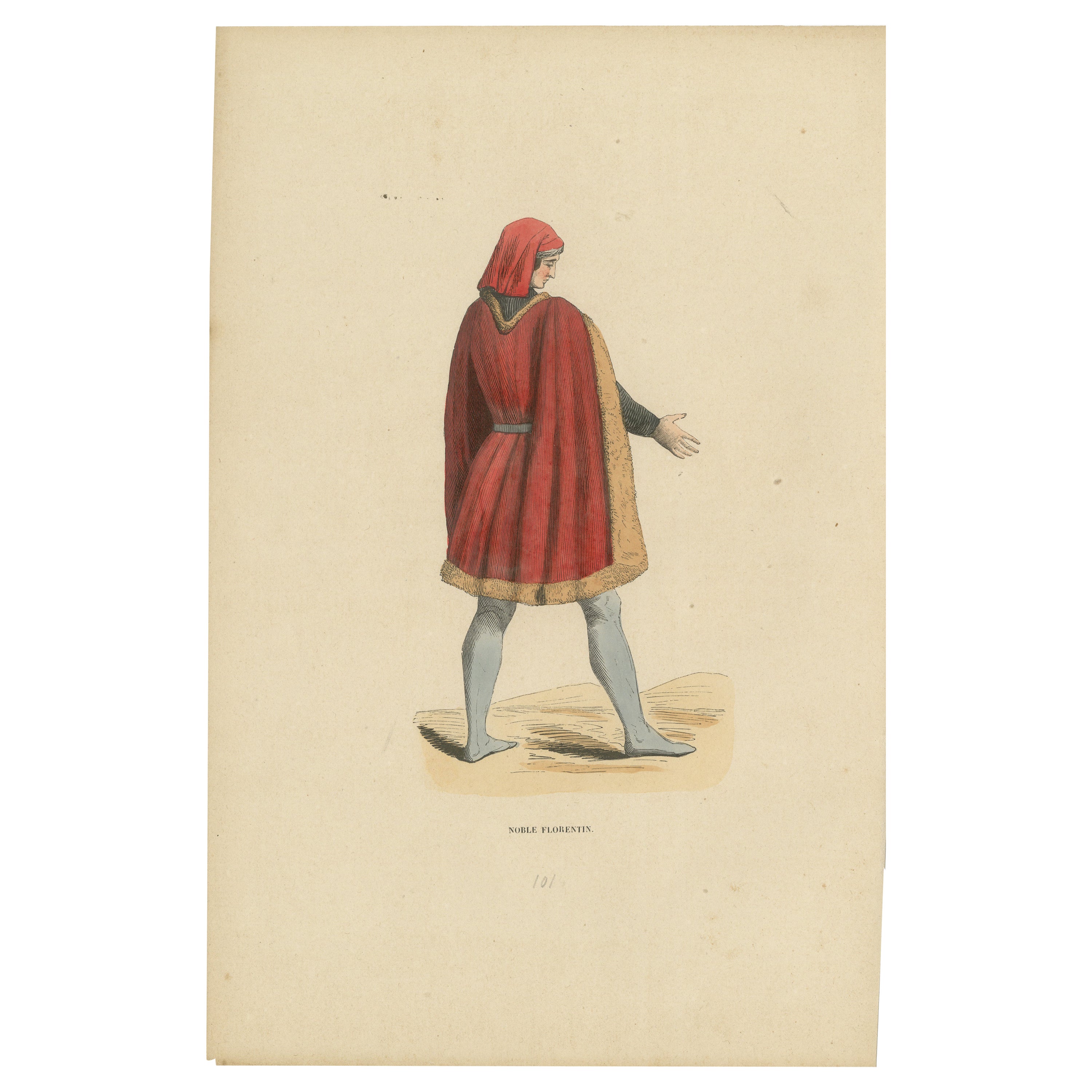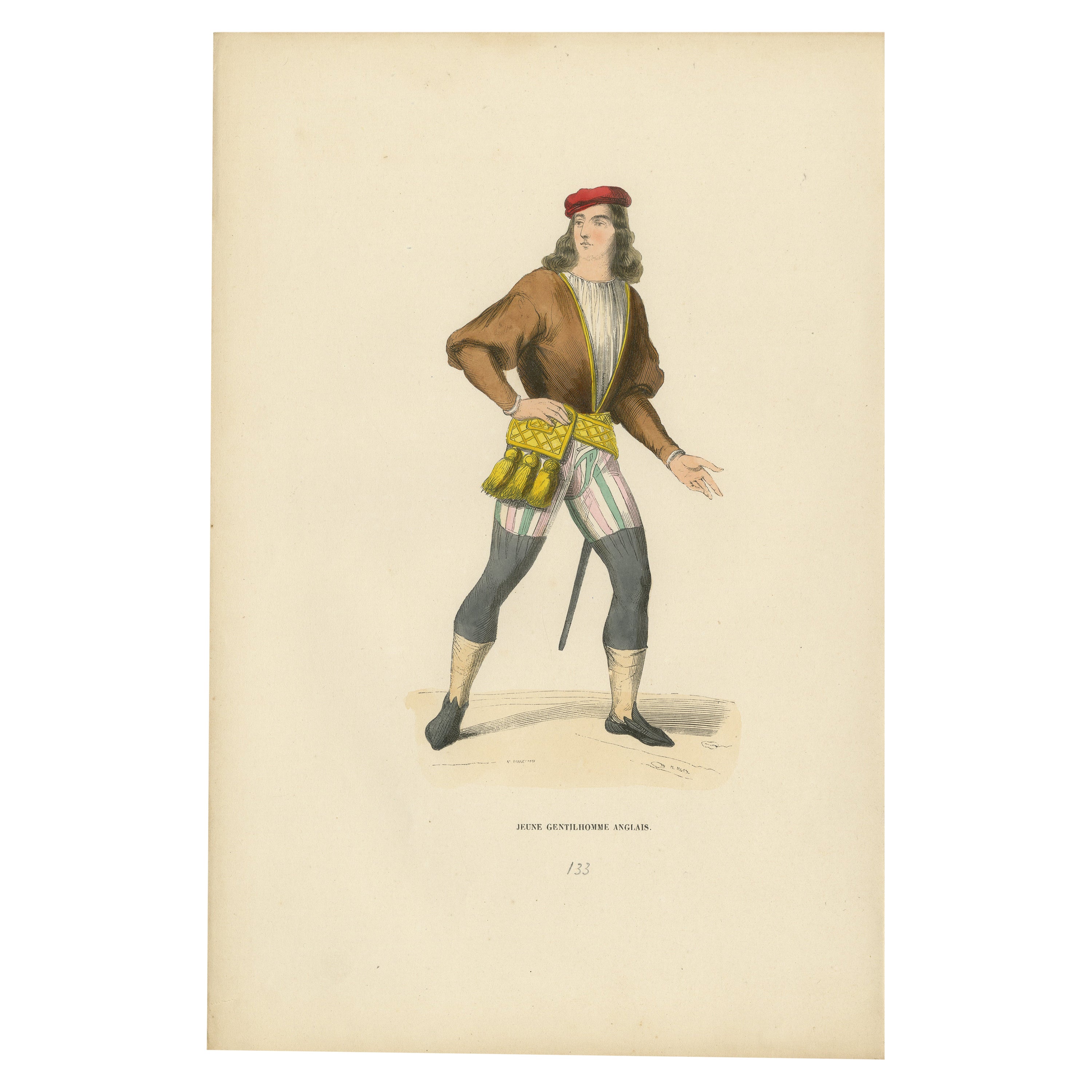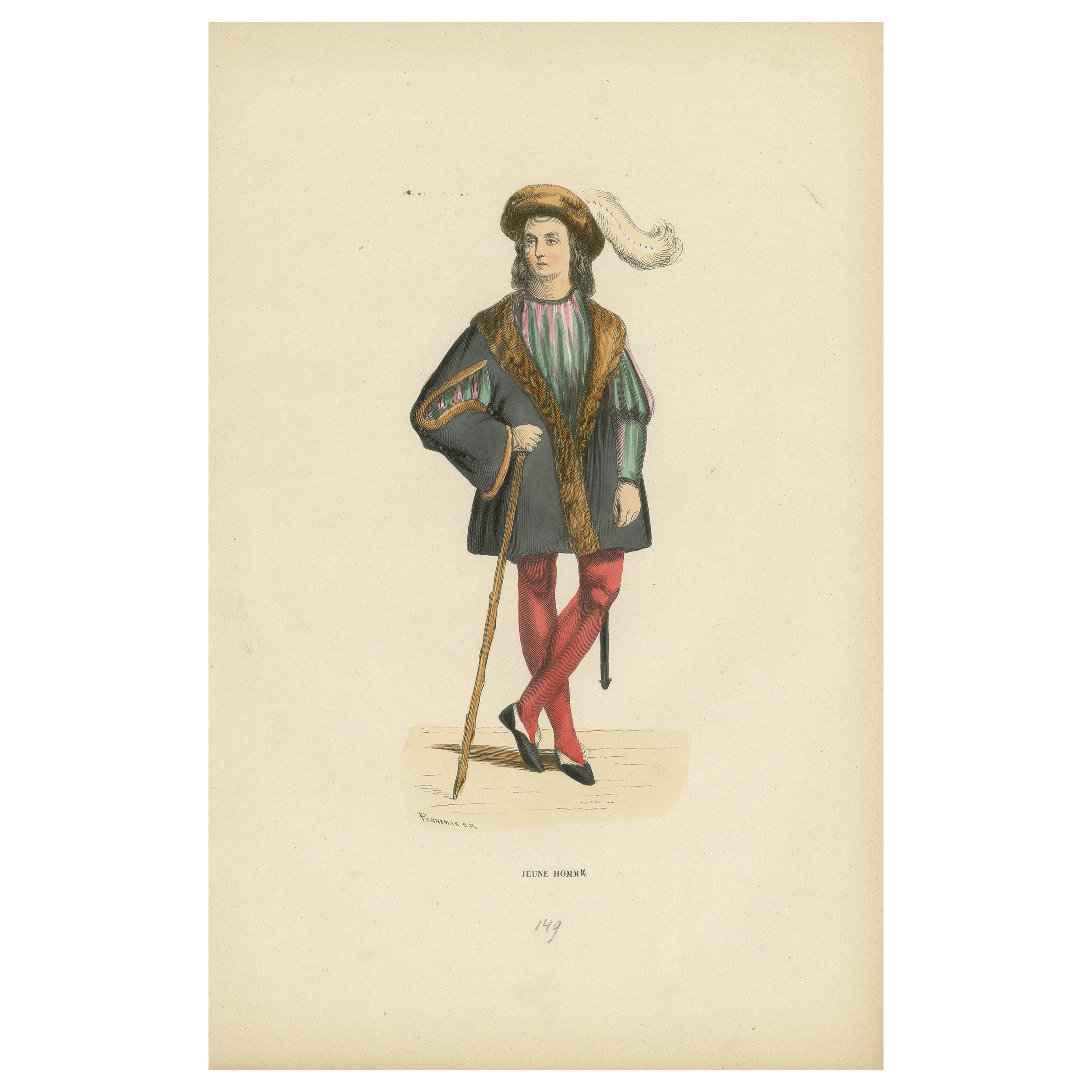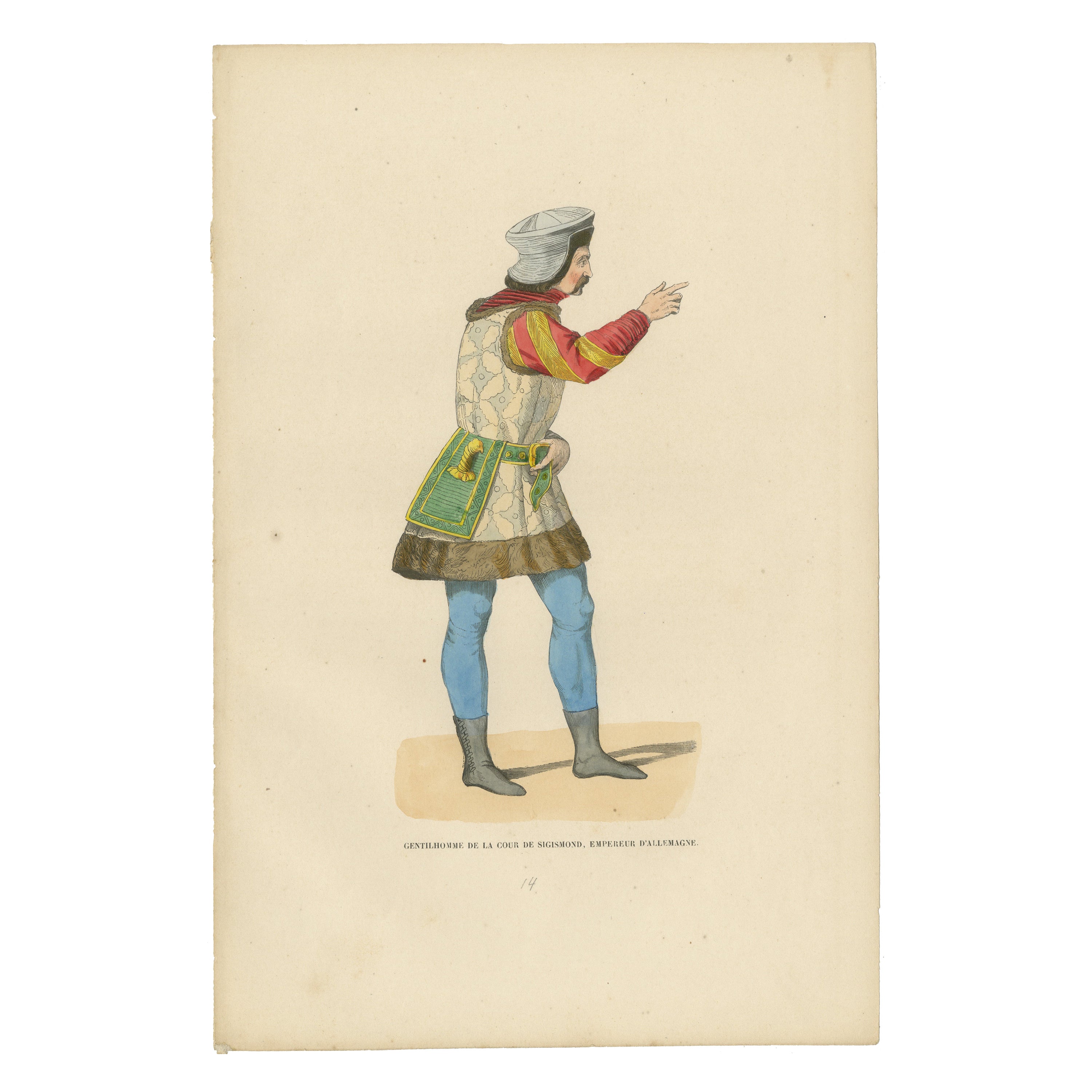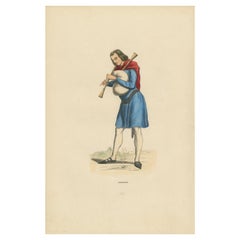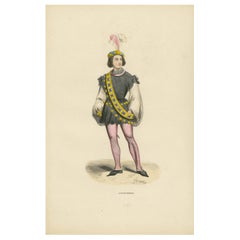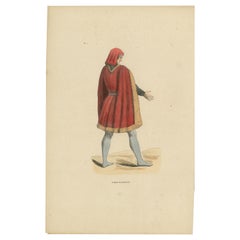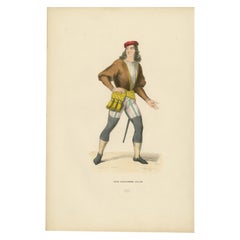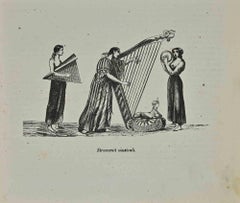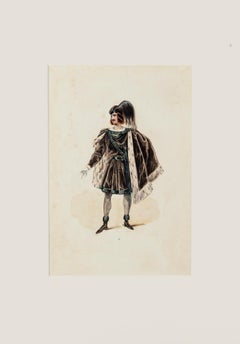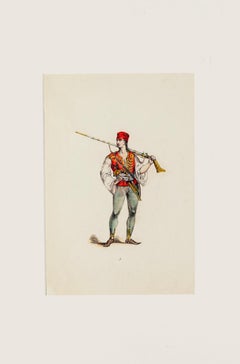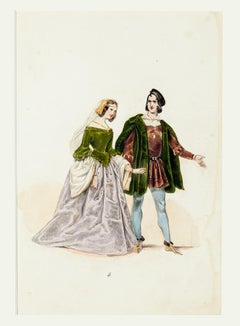Items Similar to The Melancholic Minstrel: A Musical Performer's Attire, Published in 1847
Want more images or videos?
Request additional images or videos from the seller
1 of 6
The Melancholic Minstrel: A Musical Performer's Attire, Published in 1847
$172.53
$215.6720% Off
£128.42
£160.5220% Off
€144
€18020% Off
CA$236.33
CA$295.4120% Off
A$262.85
A$328.5620% Off
CHF 137.25
CHF 171.5620% Off
MX$3,198.57
MX$3,998.2120% Off
NOK 1,752.90
NOK 2,191.1220% Off
SEK 1,643.91
SEK 2,054.8920% Off
DKK 1,096.22
DKK 1,370.2820% Off
Shipping
Retrieving quote...The 1stDibs Promise:
Authenticity Guarantee,
Money-Back Guarantee,
24-Hour Cancellation
About the Item
Title: "The Melancholic Minstrel: A Musical Performer's Attire in 'Costume du Moyen Âge'"
Description: This expressive lithograph from the 1847 collection "Costume du Moyen Âge" portrays a medieval minstrel, a traveling musician, and storyteller of the Middle Ages. The minstrel is captured in a moment of repose, eyes closed, as if lost in the music he creates or perhaps in contemplation of his next performance.
His attire is a colorful expression of his profession, with a vibrant red cloak that drapes over his shoulders, frayed at the edges to suggest his nomadic lifestyle. The cloak is a sharp contrast to the more subdued hues of his underlying garments. He wears a blue tunic, accented with golden embellishments that catch the eye, suggesting a love for flair and presentation.
The instrument he embraces is a harp, an emblem of the minstrel's craft, with its strings and soundbox detailed in the lithograph. The minstrel's leggings are a mix of green and blue, patterned in a way that is likely to draw attention in any public square or noble court where he performs.
His headwear is a simple, flat cap that sits back on his head, practical for a life spent traveling and performing outdoors. The minstrel's footwear is modest, befitting his itinerant nature.
This image is not just a study in the historical fashion of minstrels but also a glimpse into the role of the medieval entertainer. It reveals the importance of music and storytelling in the cultural life of the Middle Ages and the minstrel's place within that world, bridging the social gaps between peasants, clergy, and nobility with his art. The lithograph reflects the romanticized vision of the minstrel as both an artist and a figure of medieval lore.
The colors have a nice glow over them. Historically, egg whites, known as glair, and sometimes egg yolk were indeed used in illumination and painting, particularly in manuscripts, to give colors a brighter appearance and to add a sheen or gloss to the work. This technique was quite common during the Middle Ages and into the Renaissance.
Egg whites can be applied as a varnish over pigments to enhance their brightness and to protect the colors. This application could make the colors appear more vivid and also add a slight glossy sheen to the surface of the image.
Egg yolk, on the other hand, was commonly used as a binding agent in paint. It forms the basis of tempera paint, a medium that was widely used before the advent of oil painting. Egg yolk helps to create a durable and long-lasting color that adheres well to various surfaces.
In the context of the print from 1847, it's less likely that egg whites or yolks were used directly on the print, as by that time, commercial printing processes would have been more advanced and less reliant on such manual methods. However, if this print is a representation of an earlier style or is meant to mimic the appearance of hand-painted manuscripts, the original artists might have employed techniques or materials that gave a similar effect to those achieved with egg-based binders and varnishes.
- Dimensions:Height: 10.63 in (27 cm)Width: 7.09 in (18 cm)Depth: 0 in (0.02 mm)
- Materials and Techniques:
- Period:
- Date of Manufacture:1847
- Condition:Good. Overal light toning and light soiling but the image itself clean and hand-colored almost 200 years ago and still in expliciet colors. Aged paper with typically warm, yellowish-brown hue, mostly around the edges. Study the images carefully.
- Seller Location:Langweer, NL
- Reference Number:Seller: BG-13635-1201stDibs: LU3054337927682
About the Seller
5.0
Recognized Seller
These prestigious sellers are industry leaders and represent the highest echelon for item quality and design.
Platinum Seller
Premium sellers with a 4.7+ rating and 24-hour response times
Established in 2009
1stDibs seller since 2017
2,502 sales on 1stDibs
Typical response time: <1 hour
- ShippingRetrieving quote...Shipping from: Langweer, Netherlands
- Return Policy
Authenticity Guarantee
In the unlikely event there’s an issue with an item’s authenticity, contact us within 1 year for a full refund. DetailsMoney-Back Guarantee
If your item is not as described, is damaged in transit, or does not arrive, contact us within 7 days for a full refund. Details24-Hour Cancellation
You have a 24-hour grace period in which to reconsider your purchase, with no questions asked.Vetted Professional Sellers
Our world-class sellers must adhere to strict standards for service and quality, maintaining the integrity of our listings.Price-Match Guarantee
If you find that a seller listed the same item for a lower price elsewhere, we’ll match it.Trusted Global Delivery
Our best-in-class carrier network provides specialized shipping options worldwide, including custom delivery.More From This Seller
View AllJongleur of the Medieval Times: A Musician's Craft in the Middle Ages, 1847
Located in Langweer, NL
This hand-colored engraving, titled "Jongleur," portrays a medieval entertainer, a precursor to modern-day musicians and performers. The term "jongleur" denotes a versatile artist commonly seen in medieval courts and public spaces, engaging audiences with music, poetry, and storytelling.
In this print, the jongleur is shown playing a flute-like instrument, focused intently on his performance. His attire is strikingly colored, with a blue tunic that falls above the knee, allowing for ease of movement during his performance. The tunic is cinched at the waist by a darker belt, which helps to secure his garment during his active profession. Over his shoulders, he wears a red cape, which may symbolize his role as an entertainer, often brightly dressed to stand out in a crowd.
He wears tight red hose, a common element of medieval clothing...
Category
Antique 1840s Prints
Materials
Paper
$162 Sale Price
20% Off
The Gallant Courtier: A Nobleman's Fashion in 'Costume du Moyen Âge, 1847
Located in Langweer, NL
Title: "The Gallant Courtier: A Nobleman's Fashion in 'Costume du Moyen Âge'"
Description: This 1847 lithograph from the "Costume du Moyen Âge" collection depicts a nobleman dressed...
Category
Antique 1840s Prints
Materials
Paper
$134 Sale Price
20% Off
Florentine Nobleman of the Middle Ages, 1847
Located in Langweer, NL
Title: "Civilian Costume at the End of the 15th Century"
Description: The image is a print from a series the "Costume du Moyen Age" dated 1847, and titled "Costume Civil de la Fin du XVe Siècle," which translates to "Civilian Costume at the End of the 15th Century." It showcases a man of status, possibly a noble or a wealthy burgher, standing in a poised and confident manner.
He is attired in an ornate cloak covered in a complex pattern of fleur-de-lis and cross motifs, indicative of wealth and possibly a connection to royalty or high social rank. The cloak is open at the front to reveal a blue doublet with a belt, and he wears red hose—a fashion staple of the late medieval period. His footwear is also red, which stands out against the more subdued tones of his outfit.
On his head, he sports a fur-trimmed hat, adding to the luxuriousness of his attire. In one hand, he holds a long staff, which serves as both a walking aid and a symbol of authority. His other hand rests on the hilt of a dagger, further indicating his readiness to defend his status or engage in the political or civic matters of his time.
The artist has skillfully rendered the textiles and accessories with great care, emphasizing the fashion and social cues of the late 15th-century European society.
The colors have a nice glow over them. Historically, egg whites, known as glair, and sometimes egg yolk were indeed used in illumination and painting, particularly in manuscripts, to give colors a brighter appearance and to add a sheen or gloss to the work. This technique was quite common during the Middle Ages...
Category
Antique 1840s Prints
Materials
Paper
$124 Sale Price
20% Off
Stylish Swagger: A Young English Gentleman in The Middle Ages, Published in 1847
Located in Langweer, NL
Title: "Stylish Swagger: A Young English Gentleman in 'Costume du Moyen Âge'"
Description: This lithograph from the 1847 publication "Costume du Moyen Âge" captures the confident st...
Category
Antique 1840s Prints
Materials
Paper
$153 Sale Price
20% Off
Youthful Elegance: A Young Gentleman's Attire in 'Costume du Moyen Âge', 1847
Located in Langweer, NL
Title: "Youthful Elegance: A Young Gentleman's Attire in 'Costume du Moyen Âge'"
Description: This lithograph, part of the 1847 "Costume du Moyen Âge" series, depicts a young gentle...
Category
Antique 1840s Prints
Materials
Paper
$162 Sale Price
20% Off
Courtly Splendor: A Nobleman at Emperor Sigismund's Court, 1847
Located in Langweer, NL
The image depicts a man identified as a "Gentilhomme de la cour de Sigismond, empereur d'Allemagne," which translates to "Gentleman of the court of Sigismund, Emperor of Germany."
This individual is portrayed in a profile stance, dressed in attire that is indicative of the high-status courtiers during the time of Emperor Sigismund, who reigned in the early 15th century. He is wearing a turban-like headgear, which reflects the influence of Eastern fashion on European court attire, possibly due to the Ottoman influence or the general exchange of culture during the Crusades and subsequent interactions.
His doublet is richly patterned and he has puffed sleeves in red, which were fashionable among the nobility during the period. The garment is accented with a decorative belt that holds what appears to be a purse or a pouch. He also sports tight blue hose and pointed shoes, which complete the ensemble typical of a nobleman or a high-ranking court official in the Holy Roman Empire.
Egg whites can be applied as a varnish over pigments to enhance their brightness and to protect the colors. This application could make the colors appear more vivid and also add a slight glossy sheen to the surface of the image.
Egg yolk, on the other hand, was commonly used as a binding agent in paint. It forms the basis of tempera paint, a medium that was widely used before the advent of oil painting. Egg yolk helps to create a durable and long-lasting color that adheres well to various surfaces.
In the context of the print from 1847, it's less likely that egg whites or yolks were used directly on the print, as by that time, commercial printing processes would have been more advanced and less reliant on such manual methods. However, if this print is a representation of an earlier style or is meant to mimic the appearance of hand-painted manuscripts...
Category
Antique 1840s Prints
Materials
Paper
$153 Sale Price
20% Off
You May Also Like
Musical Instruments - Ancient Costumes - Lithograph - 1862
Located in Roma, IT
Musical Instruments - Ancient Costumes is a lithograph on paper realized in 1862.
The artwork belongs to the Suite Uses and customs of all the peoples of the universe: " History of ...
Category
1860s Modern Figurative Prints
Materials
Lithograph
Costume - Original Hand-Colored Lithograph - 19th Century
Located in Roma, IT
Costume is original Hand-colored lithograph realized by an Anonymous artist in the late XIX century.
Included a Passepartout: 52.5 x 37cm.
Very good conditions.
The artwork represents the traditional costume, skillfully depicted through soft and precise strokes, the artwork is created with congruous harmonious colors from historical costume...
Category
19th Century Figurative Prints
Materials
Lithograph
Costume - Original Hand-colored Lithograph - 19th Century
Located in Roma, IT
Costume is original Hand-colored lithograph realized by an Anonymous artist in the late XIX century.
Included a Passepartout: 52.5 x 37cm.
Very good conditions.
The artwork represents the traditional costume by light and bright colors, skillfully depicted through soft and precise strokes, the artwork is created with congruous harmonious colors from historical costume...
Category
19th Century Modern Figurative Prints
Materials
Lithograph
Ancient Costume - Original Lithograph - Mid 19th Century
Located in Roma, IT
Ancient Costume is an original lithograph hand-colored, realized by an anonymous artist of the XIX century
The state of preservation of the artwork is...
Category
Mid-19th Century Figurative Prints
Materials
Lithograph
Original Vintage Lithograph, 'Wissembourg Guitar', France c. 1880
Located in Melbourne, Victoria
Original vintage lithograph, 'Wissembourg Guitar', France: c. 1880
"This poster was created by the C. Burckardt printing firm, and is pa...
Category
Antique 1880s French Romantic Posters
Materials
Paper
$1,600 Sale Price
20% Off
Theatrical Costume - Original Lithograph - Early 20th Century
Located in Roma, IT
Theatrical Costume is a splendid hand lithograph engraved by Anonymous Artist in the Early 20th Century.
The state of preservation of the artwork is e...
Category
Early 20th Century Modern Figurative Prints
Materials
Lithograph
More Ways To Browse
Green Egg Used
Antique Silver Boxes Repousse
Antique Storm Glass
Antique Thimbles
Antique Victorian Grandfather Clock
Antique Wooden Swan
Art Deco Bed Frame Queen
Art Deco Buffet Mirror
Art Deco Desk Statue
Art Deco Full Bed
Art Deco Glass Shelving
Astronomical Clock
Baker Dining Buffet
Baker Neoclassical Dining
Baker New World Collection
Baroque Headboard
Bear Bookends
Bi Discs
